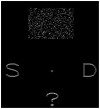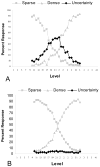The psychological organization of "uncertainty" responses and "middle" responses: a dissociation in capuchin monkeys (Cebus apella)
- PMID: 19594282
- PMCID: PMC3901429
- DOI: 10.1037/a0014626
The psychological organization of "uncertainty" responses and "middle" responses: a dissociation in capuchin monkeys (Cebus apella)
Abstract
Some studies of nonhuman animals' metacognitive capacity encourage competing low-level, behavioral descriptions of trial-decline responses by animals in uncertainty-monitoring tasks. To evaluate the force of these behavioral descriptions, the authors presented 6 capuchin monkeys (Cebus apella) with 2 density discrimination tasks between sparse and dense stimuli. In one task, difficult trials with stimuli near the middle of the density continuum could be declined through an "uncertainty" response. In the other task, making a "middle" response to the same stimuli was rewarded. In Experiment 1, capuchins essentially did not use the uncertainty response, but they did use the middle response. In Experiment 2, the authors replicated this result with 5 of 6 monkeys while equating the overall pace and reinforcement structure of the 2 tasks, although 1 monkey also showed appropriate use of the uncertainty response. These results challenge a purely associative interpretation of some uncertainty-monitoring performances by monkeys while sharpening the theoretical question concerning the nature of the psychological signal that occasions uncertainty responses.
Figures






References
-
- Angell F. On judgments of “like” in discrimination experiments. American Journal of Psychology. 1907;18:253.
-
- Ashby FG, Alfonso-Reese LA, Turken AU, Waldron EM. A neuropsychological theory of multiple systems in category learning. Psychological Review. 1998;105:442–481. - PubMed
-
- Ashby FG, Waldron EM. The nature of implicit categorization. Psychonomic Bulletin & Review. 1999;6:363–378. - PubMed
-
- Benjamin AS, Bjork RA, Schwartz BL. The mismeasure of memory: When retrieval fluency is misleading as a metacognitive index. Journal of Experimental Psychology: General. 1998;127:55–68. - PubMed
-
- Beran MJ. Monkeys (Macaca mulatta and Cebus apella) track, enumerate, and compare multiple sets of moving items. Journal of Experimental Psychology: Animal Behavior Processes. 2008;34:63–74. - PubMed

